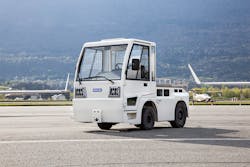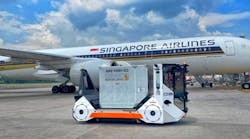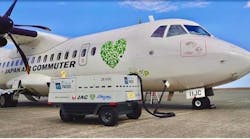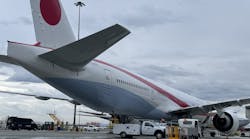It’s an electrifying time to be alive and working in the aviation industry. With more and more eyes turning their attention to the climate, and more and more minds turning environmentally-conscious, electric power, from plane to pushback, is making its way across the industry. One of the companies bringing that electric power to towing tractors is MULAG, who has been manufacturing their electric-powered tractor, the Comet 3 E, for 15 years.
“The company was founded in 1953 and produces airport ground support vehicles now for more than 55 years, starting with conveyor vehicles in 1964, towing tractors and container pallet transporters in 1971. With two production sites in the southwest of Germany, it has been possible in all these years to achieve high quality ‘made in Germany’ vehicles with great innovative power. Airport vehicles from MULAG are used worldwide with great success,” says Oliver Kesy, MULAG’s marketing manager.
Innovative power is just what was behind the creation of the Comet 3 E, as Kesy describes the Comet 3 E was one release at a time when electric vehicles were a relatively rare sight.
“Customers asked for a tractor that was emission-free, small and maneuverable – especially for work situations in the terminal and on the apron. At that time, electric drive technology was hardly widespread at airports,” says Kesy. “The Comet 3 E towing tractor is part of a product line with more powerful electric airport tractors designed for heavy-duty applications including cargo and pushback of smaller and medium-sized aircraft.”
Designed with smaller airports in mind, the Comet 3 E is the solution for ground handlers working in confined spaces, like baggage sorting areas, says Kesy. The all-electric power of the Comet 3 E also offers the benefit of being emission free, ensuring ground handlers have clean air around them as they work in those tight spaces.
“It offers an emission-free alternative to conventional vehicles with combustion engines. For technical reasons, an electric drive is also much less subject to wear and tear and requires much less maintenance,” Kesy says.
Some of the features of the Comet 3 E include: a choice of sliding or hinged doors for getting in and out of the tractor in narrow areas, such as hangars or baggage areas; an integrated loading platform for transporting materials, tools and baggage; ¬a clear view on the rear tow hitch; and an optimized steering geometry for extra low tire wear at steering angles up to 70 degrees.
“The Comet 3 E is CO2-neutral, emission-free, provides low noise pollution for the driver and environment, features an ergonomic cockpit, rear camera and innovative control panel,” adds Kesy. “Features include hydraulically suspended seats and an adjustable steering wheel, clearly arranged operating controls in the driver’s field of vision including a control panel with display for controlling central vehicle functions and for displaying the live image of the rear view camera. There are many other features and options that can be installed according to the customer's requirements, and the electric tractor series Comet 3 E, Comet 4 E and Comet 6 E has just been completely revised and currently offers the latest state-of-the-art technology.
“It has undergone two major updates since then, bringing improved chassis and cabin design as well as more electronic options like the control panel with display. In addition, the drive and battery technologies have been continuously further developed,” Kesy continues.
To learn to operate the Comet 3 E, Kesy says all that is required is a basic MULAG instruction. “And of course the local airport requirements must also be met,” he says. “The driver will quickly find his way around thanks to the intuitive operation.”
To charge the Comet 3 E’s battery, either an internal device can be used or the tractor can be charged by external means, with charging time being strongly dependent on age of the battery and the remaining charge in it.
And while climate will have an impact on the tractor, Kesy says that the Comet 3 E can be used anywhere in the world, and that MULAG offers special equipment kits for particularly hot or cold climates, too, keeping the Comet 3 E operating optimally.
“Electric airport vehicles are a bridge technology towards more efficient, low-consumption and emission-free vehicles,” adds Kesy. “However, they are still limited by the current state of battery technology, which is constantly improving.”





